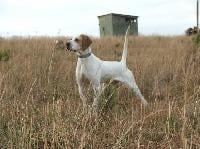Rock Ptarmigan - Grouse Hunting - Upland Hunting
View Recipes | Gamebird Services | Gamebird Hunts | View Photos

Description
Rock ptarmigan is a medium-sized gamebird in the grouse family. This bird is well adapted to harsh surroundings with well-camouflaged white winter plumage & mottled brown plumage in summer. Usually, ptarmigans are plump chicken-like birds with a small head, short neck, small bill, and large feathered feet. The rock ptarmigan is 32 to 36 cm long, weighs 440 to 640g, and has a 54 to 60 cm wingspan. The rock ptarmigan can be distinguished from willow ptarmigan using their habitats. Rock ptarmigan is smaller with a delicate bill, and they prefer living in high elevations.
Color pattern
In winter, the rock ptarmigans are white with dark lores, eyes, bill, and tail feathers. Although the breeding males have scarlet combs above their eyes, they are white until midsummer. Then, they molt into a brown plumage with dark tail feathers and conspicuous dark barring. However, their legs and wings remain white. On the other hand, breeding females have dark and pale brown mottling to camouflage.
Habitat
These gamebirds prefer nesting in dry, barren, and stony areas of alpine and tundra. Sometimes, these birds can live in shrubby areas and openings in the boreal forests.
Feeding behavior
Rock ptarmigan forages while walking. These gamebirds use their bills to pick vegetation and nip off food. The birds can also feed on some insects such as snails and spiders to supplement their diet.
Diet is mostly leaves, buds, leaves, and seeds. Adults are mainly vegetarian, feeding on flowers, leaves, catkins, berries, buds, and seeds. Significant sources of food include alder, crowberry, willow, dwarf birch, and saxifrage.
Nesting
The female mostly builds the nest in a shallow depression lined with some feathers, grass, moss, and lichen. The nest is usually built on a barren, rocky area near a large rock. The males defend the territory with a display flight in spring. The male rock ptarmigan flaps rapidly, then glide high and flutters to the ground while giving a staccato call.
During their courtship displays, the male raises the red combs above the eyes, fans his tail, and walks in circles around the female. To impress the breeding females, the male drags one of its wings on the ground.
Eggs
Rock ptarmigan lays 4 to 13 pale buff eggs with brown spots, and the females incubate the eggs for about 21 days. The downy chicks leave the nest a day after hatching. Female rock ptarmigan tends the young, although the young ones feed themselves. The chicks can start flying after 7 to 10 days. However, after 10 to 12 weeks, the young are independent, leaving the nest to live on their own.



















